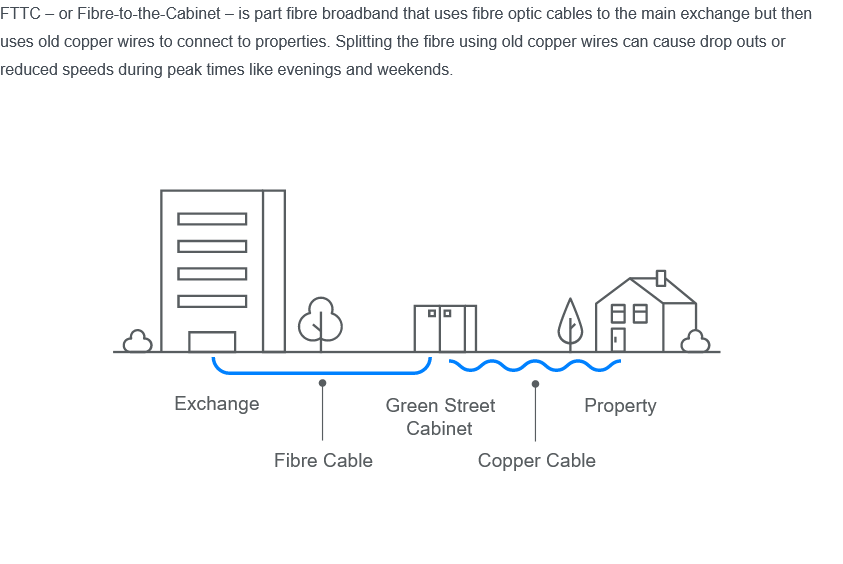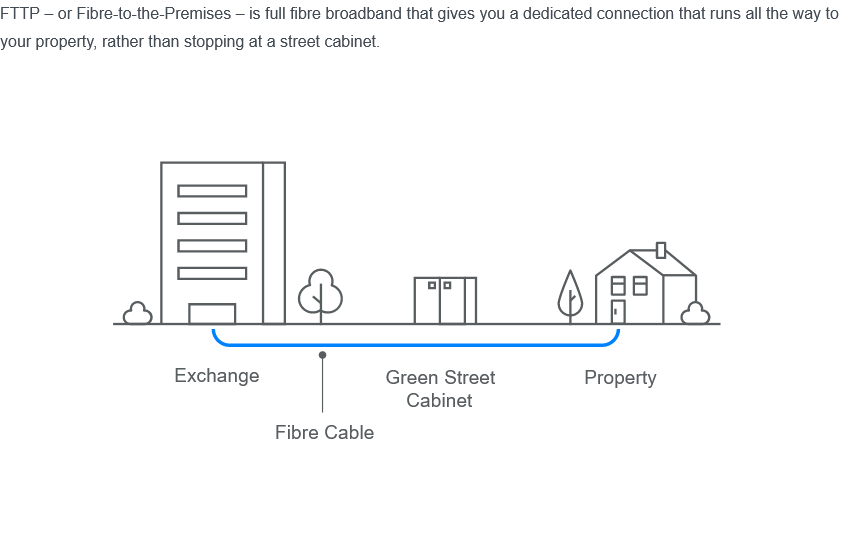Fibre Broadband Deals
Use our UK address level accurate broadband comparison service to save money.
Switch broadband providers with us and you could save up to £180.48 per annum*
Today's Special Offers:
Fibre Broadband Deals
Fibre broadband is defined as a broadband connection which is delivered through fibre optic cables. Unlike the traditional copper cables used for 'Standard broadband', fibre has a glass core and this enables information to be transmitted through them using light rather than electrical signals. Therefore, fibre optic cables can deliver data at rates thousands of times faster than copper cables.
When searching the internet for fibre broadband packages you'll often see services being marketed as "standard broadband", "superfast broadband" or "ultrafast broadband". These terms are usually based on the maximum download speed available with the service. Here are Ofcom's official definitions of each service:
- Standard broadband (download speeds of less than 30Mbps). All home broadband services delivered through ADSL technology using an Openreach phone line fall within this category.
- Superfast broadband (download speeds of 30Mbps to 300Mbps). The term 'superfast broadband' is used to distinguish home broadband services with a download speed of more than 30Mbps. This includes all fibre-to-the-cabinet (FTTC) services as well as the lower tiers of Virgin's cable-based home broadband service. Broadband that's delivered through G.fast or 4G technology would also normally be classified as offering superfast speeds.
- Ultrafast broadband (download speeds of more than 300Mbps). Ultrafast broadband refers to services offering a download speed of more than 300Mbps. Full fibre services (also known as fibre-to-the-premises or FTTP) are the gold standard within this category. However, the higher tiers of Virgin Media's cable-based broadband and 5G broadband would also count as ultrafast broadband.
Fibre-To-The-Cabinet (FTTC) Broadband
The standard fibre broadband packages sold in the UK are actually fibre-to-the-cabinet services, also known simply as FTTC. This is the most common way that providers deliver fibre broadband to your home.

With FTTC, a fibre connection is used from the telephone exchange to your nearest green street cabinet. That's as far as the fibre connection goes, and a copper connection is then used from the street cabinet to your home, this is commonly known as the 'last mile' connection.
If you have a part-fibre broadband connection, it's possible to obtain download speeds of 80Mbps and upload speeds of up to 20Mbps.
Although fibre broadband isn't available in all areas of the UK yet, Ofcom states that around 95% of homes and businesses in the United Kingdom have access to get a fibre-to-the-cabinet service.
DOCSIS Cable
Virgin Media provides a home broadband service using cable and a technology known as DOCSIS. DOCSIS is still regarded as a fibre-to-the-cabinet service but it uses coaxial cables (Hybrid Fibre Coax) between the cabinet and your home. This means that you can expect your Wi-Fi's performance to be a lot better than on regular FTTC which uses basic copper cables rather than a Hybrid Fibre Coax cable.
On Virgin's latest Gig1 broadband service, it's possible to obtain average download speeds of 1,130Mbps. This uses the latest version of DOCSIS 3.1. Upload speeds of up to 54Mbps also come with Virgin Media's Gig1 package. In areas where Gig1 broadband is not yet available, Virgin Media still offers download speeds of up to 500Mbps.
Fibre-To-The-Premises (FTTP) Broadband
Fibre-to-the-premises is also referred to as full-fibre broadband, this is because the entire line (from your local telephone exchange to your property) is made of fibre optic cable.

One of the main benefits of FTTP technology is that it's capable of providing customers with lightning fast download speeds, usually up to 1000Mbps. With full fibre, there is a lot more reliability in terms of connection and there is also lower latency. A full fibre broadband package is great for those that need to download and upload large files without any hold-up. It's also useful for those who wish to stream, make video calls with no issues and play online video games without any lag.
However, installing FTTP technology can be very costly and the availability of full fibre in the UK, at the time of writing, is just over 30% homes. This is relatively small when compared to FTTC technology which is available in over 95% of homes in the UK.
Providers that offer a full fibre service
These are the ISPs (Internet Service Providers) that currently offer customers with full fibre packages:
- BT
- Community Fibre
- Cuckoo
- EE
- Hyperoptic
- Shell Energy
- Sky
- TalkTalk
- Virgin Media
- Vodafone
However, whether FTTP technology is available at your home or not depends on your address. If you're curious about whether you can get a full fibre package, use the tool at the top of this page.
Frequently Asked Questions
What's the difference between fibre broadband and standard ADSL broadband?
Copper broadband, also known as ADSL broadband, uses copper wires to deliver broadband from your local exchange to your home. ADSL broadband uses the same original copper wires that are the foundation of the nationwide telephone network that's operated by Openreach.
Fibre broadband, on the other hand, is a newer technology and replaces copper wire with fibre optic cables, which are more efficient at transmitting data. With fibre, information is converted into light and then gets sent down very thin glass tubes which are used to form part of a fibre optic cabling network. Information is then converted back to data at the other end. For that reason, fibre provides a much faster connection.
Should I choose limited or unlimited broadband?
Although limited fibre broadband may be cheaper, you'll have to be very cautious when using your Wi-Fi every month because if you cross your monthly data, there may be extra charges that you'll have to pay. If you're unsure about what package to choose, an unlimited broadband package may be most suitable.
Is a landline required to get fibre broadband?
Fortunately, a landline is not required to get a fibre broadband package. Hyperoptic, Virgin Media, BT and EE all offer various broadband packages that don't require a landline rental.
If you wish to get a BT package without a landline it will also work out to be around u00a35 cheaper per month. There are also comparable savings on offer with Virgin Media.
FTTC fibre from Internet Service Providers (ISPs) like Sky, Vodafone and TalkTalk all need a phone line to work. However, they'll still offer customers with a wide range fibre-optic broadband only deals. This will include a phone line for broadband but no other extras, such as TV or free calls. So, if you don't use the phone line, choose a package without inclusive calls and this could aid you in keeping costs down.
Is fibre broadband expensive?
Fibre broadband will tend to be more expensive than standard ADSL broadband. How much it will cost exactly depends on which provider you decide to go for. If you're hoping to find a bargain, providers like Plusnet and Post Office will be offering cheaper fibre broadband packages than the likes of Virgin Media and BT.
Fortunately, we've made it simple to find a competitively priced deal. Just use the tool at the top of this page to compare deals, directly to your address, from the UK's top fibre optic broadband providers.